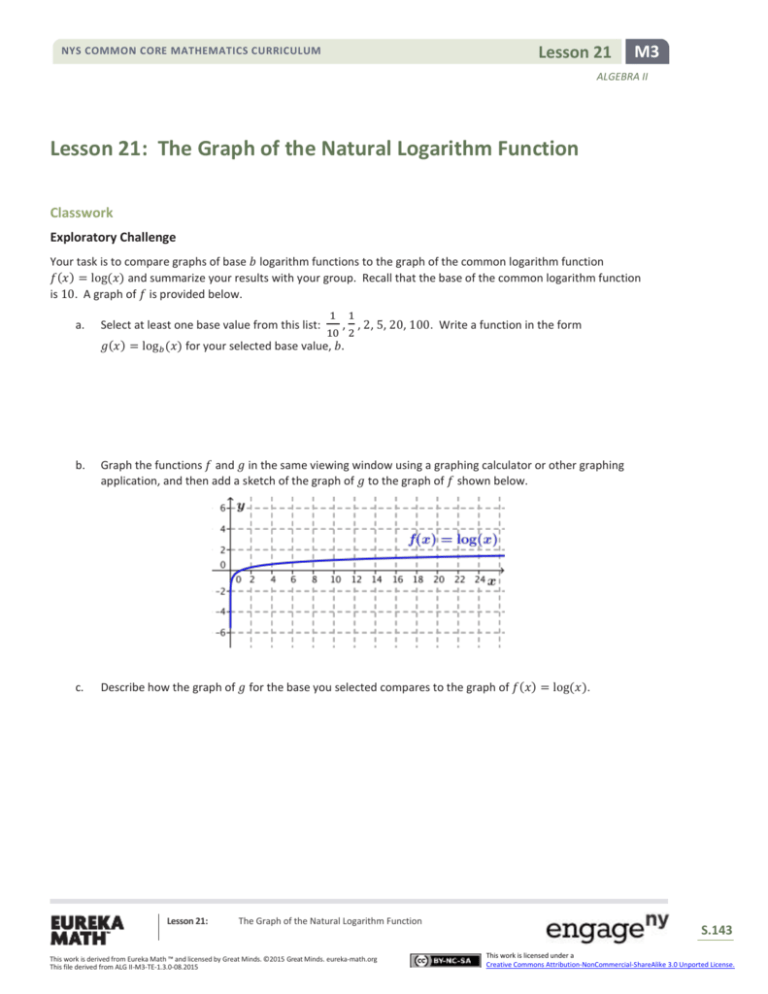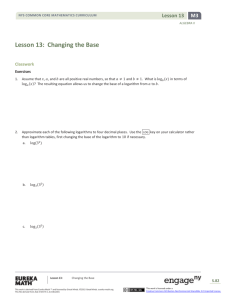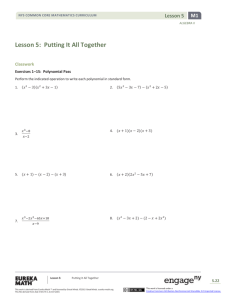Algebra II Module 3, Topic , Lesson 21: Student Version
advertisement

Lesson 21 NYS COMMON CORE MATHEMATICS CURRICULUM M3 ALGEBRA II Lesson 21: The Graph of the Natural Logarithm Function Classwork Exploratory Challenge Your task is to compare graphs of base 𝑏 logarithm functions to the graph of the common logarithm function 𝑓(𝑥) = log(𝑥) and summarize your results with your group. Recall that the base of the common logarithm function is 10. A graph of 𝑓 is provided below. a. Select at least one base value from this list: 1 1 , , 2, 5, 20, 100. Write a function in the form 10 2 𝑔(𝑥) = log 𝑏 (𝑥) for your selected base value, 𝑏. b. Graph the functions 𝑓 and 𝑔 in the same viewing window using a graphing calculator or other graphing application, and then add a sketch of the graph of 𝑔 to the graph of 𝑓 shown below. c. Describe how the graph of 𝑔 for the base you selected compares to the graph of 𝑓(𝑥) = log(𝑥). Lesson 21: The Graph of the Natural Logarithm Function This work is derived from Eureka Math ™ and licensed by Great Minds. ©2015 Great Minds. eureka-math.org This file derived from ALG II-M3-TE-1.3.0-08.2015 S.143 This work is licensed under a Creative Commons Attribution-NonCommercial-ShareAlike 3.0 Unported License. NYS COMMON CORE MATHEMATICS CURRICULUM Lesson 21 M3 ALGEBRA II d. Share your results with your group and record observations on the graphic organizer below. Prepare a group presentation that summarizes the group’s findings. How does the graph of 𝒈(𝒙) = 𝐥𝐨𝐠 𝒃 (𝒙) compare to the graph of 𝒇(𝒙) = 𝐥𝐨𝐠(𝒙) for various values of 𝒃? 0<𝑏<1 1 < 𝑏 < 10 𝑏 > 10 Exercise 1 Use the change of base property to rewrite each logarithmic function in terms of the common logarithm function. Base 𝑏 Base 10(Common Logarithm) 𝑔1 (𝑥) = log 1 (𝑥) 4 𝑔2 (𝑥) = log 1 (𝑥) 2 𝑔3 (𝑥) = log 2 (𝑥) 𝑔4 (𝑥) = log 5 (𝑥) 𝑔5 (𝑥) = log 20 (𝑥) 𝑔6 (𝑥) = log100 (𝑥) Lesson 21: The Graph of the Natural Logarithm Function This work is derived from Eureka Math ™ and licensed by Great Minds. ©2015 Great Minds. eureka-math.org This file derived from ALG II-M3-TE-1.3.0-08.2015 S.144 This work is licensed under a Creative Commons Attribution-NonCommercial-ShareAlike 3.0 Unported License. NYS COMMON CORE MATHEMATICS CURRICULUM Lesson 21 M3 ALGEBRA II Example 1: The Graph of the Natural Logarithm Function𝒇(𝒙) = 𝐥𝐧(𝒙) Graph the natural logarithm function below to demonstrate where it sits in relation to the graphs of the base-2 and base-10 logarithm functions. Example 2 Graph each function by applying transformations of the graphs of the natural logarithm function. a. 𝑓(𝑥) = 3 ln(𝑥 − 1) b. 𝑔(𝑥) = log 6 (𝑥) − 2 Lesson 21: The Graph of the Natural Logarithm Function This work is derived from Eureka Math ™ and licensed by Great Minds. ©2015 Great Minds. eureka-math.org This file derived from ALG II-M3-TE-1.3.0-08.2015 S.145 This work is licensed under a Creative Commons Attribution-NonCommercial-ShareAlike 3.0 Unported License. Lesson 21 NYS COMMON CORE MATHEMATICS CURRICULUM M3 ALGEBRA II Problem Set 1. 2. Rewrite each logarithmic function as a natural logarithm function. a. 𝑓(𝑥) = log 5 (𝑥) b. 𝑓(𝑥) = log 2 (𝑥 − 3) c. 𝑓(𝑥) = log 2 ( ) d. 𝑓(𝑥) = 3 − log(𝑥) e. 𝑓(𝑥) = 2 log(𝑥 + 3) f. 𝑓(𝑥) = log 5 (25𝑥) 𝑥 3 Describe each function as a transformation of the natural logarithm function 𝑓(𝑥) = ln(𝑥). a. 𝑔(𝑥) = 3ln(𝑥 + 2) b. 𝑔(𝑥) = −ln(1 − 𝑥) c. 𝑔(𝑥) = 2 + ln(𝑒 2 𝑥) d. 𝑔(𝑥) = log 5 (25𝑥) 3. Sketch the graphs of each function in Problem 2 and identify the key features including intercepts, decreasing or increasing intervals, and the vertical asymptote. 4. Solve the equation 1 − 𝑒 𝑥−1 = ln(𝑥) graphically, without using a calculator. 5. Use a graphical approach to explain why the equation log(𝑥) = ln(𝑥) has only one solution. 6. Juliet tried to solve this equation as shown below using the change of base property and concluded there is no solution because ln(10) ≠ 1. Construct an argument to support or refute her reasoning. log(𝑥) = ln(𝑥) ln(𝑥) = ln(𝑥) ln(10) ( ln(𝑥) 1 1 ) = (ln(𝑥)) ln(10) ln(𝑥) ln(𝑥) 1 =1 ln(10) Lesson 21: The Graph of the Natural Logarithm Function This work is derived from Eureka Math ™ and licensed by Great Minds. ©2015 Great Minds. eureka-math.org This file derived from ALG II-M3-TE-1.3.0-08.2015 S.146 This work is licensed under a Creative Commons Attribution-NonCommercial-ShareAlike 3.0 Unported License. NYS COMMON CORE MATHEMATICS CURRICULUM Lesson 21 M3 ALGEBRA II 7. Consider the function 𝑓 given by 𝑓(𝑥) = log 𝑥 (100) for 𝑥 > 0 and 𝑥 ≠ 1. a. What are the values of 𝑓(100),𝑓(10), and 𝑓(√10)? b. Why is the value 1 excluded from the domain of this function? c. Find a value 𝑥 so that 𝑓(𝑥) = 0.5. d. Find a value𝑤 so that 𝑓(𝑤) = −1. e. Sketch a graph of 𝑦 = log 𝑥 (100) for 𝑥 > 0 and 𝑥 ≠ 1. Lesson 21: The Graph of the Natural Logarithm Function This work is derived from Eureka Math ™ and licensed by Great Minds. ©2015 Great Minds. eureka-math.org This file derived from ALG II-M3-TE-1.3.0-08.2015 S.147 This work is licensed under a Creative Commons Attribution-NonCommercial-ShareAlike 3.0 Unported License.










